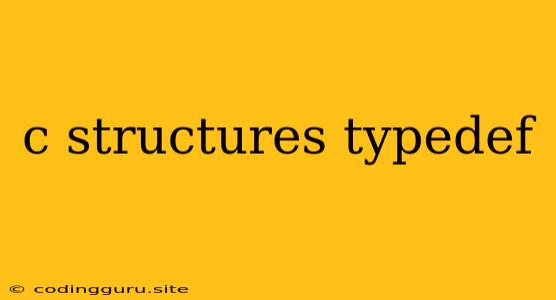Understanding typedef and Structures in C
C is a powerful and versatile programming language that allows you to create your own data types. One of the key mechanisms for achieving this is through structures and the typedef keyword. But what are they and how can they be used effectively? Let's dive into this.
What are Structures?
Structures in C are user-defined data types that allow you to group together variables of different data types. This creates a blueprint for a custom data type that can be used throughout your program. Imagine you are designing a program to manage a library. You'll need information about each book, like its title, author, genre, and ISBN. Structures come in handy here.
Here's a simple example of a structure for a book:
struct Book {
char title[100];
char author[50];
char genre[20];
int ISBN;
};
This structure defines a new data type called Book, which holds the information about a book.
The Power of typedef
While the above structure definition works, it can be a bit verbose to declare variables of this type. This is where typedef steps in. typedef is a keyword that creates an alias for an existing data type. It acts as a shortcut, making your code more readable and maintainable.
Here's how we can use typedef with our Book structure:
typedef struct Book {
char title[100];
char author[50];
char genre[20];
int ISBN;
} Book;
Now, instead of writing struct Book, we can simply use Book to declare variables. For example:
Book myBook;
Benefits of using typedef with Structures
- Improved Readability: Instead of writing
struct Book, you can use the more conciseBook. - Easier Maintenance: If you need to change the structure definition, you only need to modify it in one place.
- Code Clarity:
typedefmakes your code more self-explanatory and less cluttered.
Working with Structures: Accessing Members
Once you've defined a structure and used typedef to create an alias, you can access the individual elements of the structure (its members) using the dot operator (.).
Book myBook;
strcpy(myBook.title, "The Lord of the Rings");
strcpy(myBook.author, "J.R.R. Tolkien");
strcpy(myBook.genre, "Fantasy");
myBook.ISBN = 9780618053267;
printf("Book Title: %s\n", myBook.title);
printf("Author: %s\n", myBook.author);
printf("Genre: %s\n", myBook.genre);
printf("ISBN: %d\n", myBook.ISBN);
This code first declares a variable myBook of type Book. Then, it assigns values to each member of the structure using the dot operator. Finally, it prints the information stored in the myBook structure.
Conclusion
Using structures in combination with the typedef keyword allows you to create custom data types in C, improving code organization, readability, and maintainability. You can effectively define complex data structures to represent real-world entities like books, employees, or even geometric shapes. By using typedef you create aliases, making your code cleaner and easier to understand. This powerful combination is essential for writing efficient and well-structured C programs.
